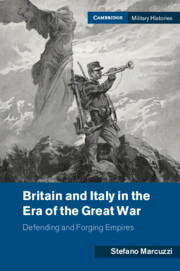Refine search
Actions for selected content:
15401 results in Military history
6 - Context
- from Part II - Integrating Italy into the Triple Entente (Spring 1915–Summer 1917)
-
- Book:
- Britain and Italy in the Era of the Great War
- Published online:
- 08 December 2020
- Print publication:
- 10 December 2020, pp 75-77
-
- Chapter
- Export citation
8 - Dealing with Recalcitrant Allies
- from Part II - Integrating Italy into the Triple Entente (Spring 1915–Summer 1917)
-
- Book:
- Britain and Italy in the Era of the Great War
- Published online:
- 08 December 2020
- Print publication:
- 10 December 2020, pp 98-132
-
- Chapter
- Export citation
18 - Versailles 1919
- from Part III - The Forked Road to Victory and Peace (Autumn 1917–Summer 1919)
-
- Book:
- Britain and Italy in the Era of the Great War
- Published online:
- 08 December 2020
- Print publication:
- 10 December 2020, pp 290-326
-
- Chapter
- Export citation
14 - Response to Military Emergencies
- from Part III - The Forked Road to Victory and Peace (Autumn 1917–Summer 1919)
-
- Book:
- Britain and Italy in the Era of the Great War
- Published online:
- 08 December 2020
- Print publication:
- 10 December 2020, pp 224-237
-
- Chapter
- Export citation
Figures
-
- Book:
- Britain and Italy in the Era of the Great War
- Published online:
- 08 December 2020
- Print publication:
- 10 December 2020, pp ix-ix
-
- Chapter
- Export citation
Copyright page
-
- Book:
- Britain and Italy in the Era of the Great War
- Published online:
- 08 December 2020
- Print publication:
- 10 December 2020, pp iv-iv
-
- Chapter
- Export citation
2 - Traditional Friendship
- from Part I - Making the Anglo-Italian Entente (1911–1915)
-
- Book:
- Britain and Italy in the Era of the Great War
- Published online:
- 08 December 2020
- Print publication:
- 10 December 2020, pp 17-27
-
- Chapter
- Export citation
Conclusions
- from Part III - The Forked Road to Victory and Peace (Autumn 1917–Summer 1919)
-
- Book:
- Britain and Italy in the Era of the Great War
- Published online:
- 08 December 2020
- Print publication:
- 10 December 2020, pp 334-342
-
- Chapter
- Export citation
Dedication
-
- Book:
- Britain and Italy in the Era of the Great War
- Published online:
- 08 December 2020
- Print publication:
- 10 December 2020, pp v-vi
-
- Chapter
- Export citation
13 - Clash of Responsibilities
- from Part III - The Forked Road to Victory and Peace (Autumn 1917–Summer 1919)
-
- Book:
- Britain and Italy in the Era of the Great War
- Published online:
- 08 December 2020
- Print publication:
- 10 December 2020, pp 209-223
-
- Chapter
- Export citation
Epilogue: Bloody Christmas in Fiume
- from Part III - The Forked Road to Victory and Peace (Autumn 1917–Summer 1919)
-
- Book:
- Britain and Italy in the Era of the Great War
- Published online:
- 08 December 2020
- Print publication:
- 10 December 2020, pp 327-333
-
- Chapter
- Export citation
1 - Context
- from Part I - Making the Anglo-Italian Entente (1911–1915)
-
- Book:
- Britain and Italy in the Era of the Great War
- Published online:
- 08 December 2020
- Print publication:
- 10 December 2020, pp 15-16
-
- Chapter
- Export citation
Maps
-
- Book:
- Britain and Italy in the Era of the Great War
- Published online:
- 08 December 2020
- Print publication:
- 10 December 2020, pp x-x
-
- Chapter
- Export citation
9 - Peripheral Competition
- from Part II - Integrating Italy into the Triple Entente (Spring 1915–Summer 1917)
-
- Book:
- Britain and Italy in the Era of the Great War
- Published online:
- 08 December 2020
- Print publication:
- 10 December 2020, pp 133-153
-
- Chapter
- Export citation
15 - Re-shaping Allied Grand Strategy
- from Part III - The Forked Road to Victory and Peace (Autumn 1917–Summer 1919)
-
- Book:
- Britain and Italy in the Era of the Great War
- Published online:
- 08 December 2020
- Print publication:
- 10 December 2020, pp 238-254
-
- Chapter
- Export citation
Contents
-
- Book:
- Britain and Italy in the Era of the Great War
- Published online:
- 08 December 2020
- Print publication:
- 10 December 2020, pp vii-viii
-
- Chapter
- Export citation
17 - Divided at the Finish Line
- from Part III - The Forked Road to Victory and Peace (Autumn 1917–Summer 1919)
-
- Book:
- Britain and Italy in the Era of the Great War
- Published online:
- 08 December 2020
- Print publication:
- 10 December 2020, pp 269-289
-
- Chapter
- Export citation
16 - Propaganda As a Strategy
- from Part III - The Forked Road to Victory and Peace (Autumn 1917–Summer 1919)
-
- Book:
- Britain and Italy in the Era of the Great War
- Published online:
- 08 December 2020
- Print publication:
- 10 December 2020, pp 255-268
-
- Chapter
- Export citation

Britain and Italy in the Era of the Great War
- Defending and Forging Empires
-
- Published online:
- 08 December 2020
- Print publication:
- 10 December 2020
1 - Three historiographical configurations
-
- Book:
- The Great War in History
- Published online:
- 16 November 2020
- Print publication:
- 03 December 2020, pp 6-33
-
- Chapter
- Export citation
